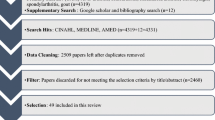Abstract
Complementary medicine (CM) is more popular than ever before. Rheumatology patients seem particularly keen to try CM. In this paper, surveys on rheumatology patients' use of CM are reviewed. The issues of perceived effectiveness, safety and costs are also addressed. In addition surveys of doctors' attitudes towards CM in rheumatology are summarised. Fourteen surveys on patients' use of CM and three on patients' attitudes towards CM were found and analysed. The results imply that the prevalence of CM varies between 30% and nearly 100%. Overall, patients perceive CM as being moderately effective. The survey contains only few data on adverse events of CM as perceived by these patients; collectively they suggest that adverse events are uncommon. Data on costs are similarly sparse; they imply that expenditure for CM is rarely high. Physicians seem to be more sceptical about CM than are their patients. It is concluded that, on average, CM is frequently used by rheumatology patients. The patients' level of satisfaction with CM is often considerable and few adverse effects are being reported. On the basis of these findings, a rigorous investigation of the effectiveness, safety and costs of CM in rheumatology seems desirable.
Similar content being viewed by others

References
Eisenberg DM, Kessler RC, Foster C, Norlock FE, Calkins DR, Delbanco TL. Unconventional medicine in the United States. N Engl J Med 1993;328:246–52.
Fisher P, Ward A. Complementary medicine in Europe. Br Med J 1994;309:107–11.
MacLennan AH, Wilson DH, Taylor AW. Prevalence and cost of alternative medicine in Australia. Lancet 1996;347:569–73.
Ernst E, Resch KL, Mills S, Hill R, Mitchell A, Willoughby M, White A. Complementary medicine—a definition. Br J Gen Pract 1995;506.
Cassileth B R, Lusk E J, Strouse T B, Bodenheimer B J. Contemporary unorthodox treatments in cancer medicine. Ann Intern Med 1984;101:105–12.
Thomas KJ, Carr J, Westlake L, Williams BT. Use of nonorthodox and conventional healthcare in Britain. Br Med J 1991;302:207–10.
Brown JH, Spitz PW, Fries JF. Unorthodox treatments in rheumatoid arthritis. Arthritis Rheum 1980;23(suppl 1):657–8.
Kronfeld JJ, Wasner C. The use of unorthodox therapies and marginal practitioners. Soc Sci Med 1982;16:1119–25.
Pullar T, Capell HA, Millar A, Brooks. Alternative medicine: costs and subjective benefit in rheumatoid arthritis. Br Med J 1982;285:1629–31.
Huilgol VR, Howell CA, Higgins MJ, Alton J, Tilly SJ, Harris RD, Brooks PM. Non-traditional medication for rheumatoid arthritis. Aust NZ Med J 1982;12:562.
Higham C, Ashcroft C, Jayson MIV. Non-prescribed treatments in rheumatic diseases. Practitioner 1983;227:1201–5.
Cassidy M, Jacobs A, Bresnihan B. The use of unproven remedies for rheumatoid arthritis in Ireland. Irish Med J 1983;76:464–5.
Struthers GR, Scott DL, Scott DGI. The use of alternative treatments by patients with rheumatoid arthritis. Rheumatol Int 1983;3:151–2.
Kestin M, Miller M, Miller L, Littlejohn G, Wahlgvist M. The use of unproven remedies for rheumatoid arthritis in Australia. Med J Austr 1985;143:516–8.
Cronan TA, Kaplan RM, Posnes L, Blumberg E, Kozin F. Prevalence of the use of unconventional remedies for arthritis in a metropolitan community. Arch Rheum 1989;32:1604–7.
Visser GJ, Peters L, Raser JJ. Rheumatologists and their patients who seek alternative care, an agreement to disagree. Br J Rheumatol 1992;31:485–90.
Krajnc I. Alternative medicine in the treatment of rheumatic diseases. Lijec Vjesn 1993;115:35–9.
Boisset M, Fitzcharles MA. Alternative medicine use by rheumatology patients in a universal health care setting. J Rheumatol 1994;21:148–52.
Arcury TA, Bernard SL, Jordan JM, Cook HL. Gender and ethnic differences in alternative and conventional arthritis remedy use among community-dwelling rural adults with arthritis. Arthritis Care Res 1996;9:384–90.
Dimmock S, Troughton PR, Bird HA. Factors predisposing to the resort of complementary therapies in patients with fibromyalgia. Clin Rheumatol 1996;15:478–82.
Velimirovic B. Alternative Heilmethoden in Österreich. Wien Klin Woschr 1989;101:774–80.
Marshall RJ, Gee R, Israel M. The use of alternative therapies by Auckland general practitioners. NZ Med J 1990;103:213–5.
Oepen I. Pseudo-Naturheilverfahren und Außenseitermethoden in der Rheumatologie. Ztschr Rheumatol 1993;52:264–74.
Ernst E. Placebo in medicine [letter]. Lancet 1995;345:65.
Ernst E, Willoughby M, Weihmayr TH. Nine possible reasons for choosing complementary medicine. Perfusion 1995;8:356–8.
Resch K, Hill S, Ernst E. Use of complementary therapies by individuals with ‘arthritis’. Clin Rheumatol 1977;16:391–5.
Woodham A. Health Education Authority guide to complementary medicine and therapies. London: Health Education Authority, 1995.
Abbot NC, White AR, Ernst E. Complementary medicine. Nature 1996;381:361.
Ernst E, De Smet PAGM. Adverse effects of complementary therapies. In: Duke, editor. Meyler's side effects. Amsterdam: Elseviert, 1996.
Ernst E, White A. Acupuncture: safety first. Br Med J 1997;314:1362.
White AR, Resch KL, Ernst E. Methods of economic evaluation in complementary medicine. Forsch Komplementärmed 1996;3:196–203.
Author information
Authors and Affiliations
Corresponding author
Rights and permissions
About this article
Cite this article
Ernst, E. Usage of complementary therapies in rheumatology: A systematic review. Clin Rheumatol 17, 301–305 (1998). https://doi.org/10.1007/BF01451009
Received:
Accepted:
Issue Date:
DOI: https://doi.org/10.1007/BF01451009



